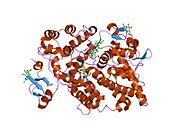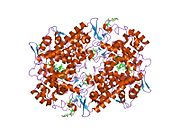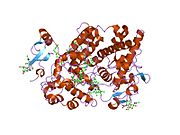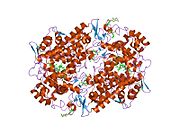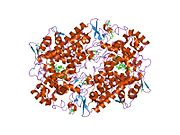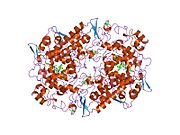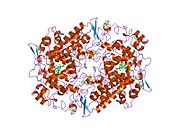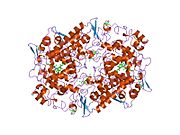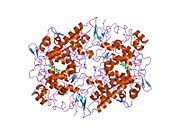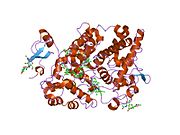Cyclooxygenase-1: Difference between revisions
m →Function: +wl |
citify | Assisted by Citation bot |
||
| Line 12: | Line 12: | ||
[[Prostaglandin]]-endoperoxide [[synthase]] (PTGS), also known as [[cyclooxygenase]] (COX), is the key enzyme in prostaglandin biosynthesis. It converts free arachidonic acid, released from membrane phospholipids at the sn-2 ester binding site by the enzymatic activity of phospholipase A2, to prostaglandin (PG) H2. The reaction involves both cyclooxygenase ([[dioxygenase]]) and hydroperoxidase ([[peroxidase]]) activity. The cyclooxygenase activity incorporates two oxygen molecules into arachidonic acid or alternate polyunsaturated fatty acid substrates, such as [[linoleic acid]] and [[eicosapentaenoic acid]]. Metabolism of [[arachidonic acid]] forms a labile intermediate peroxide, [[PGG2]], which is reduced to the corresponding alcohol, PGH2, by the enzyme’s hydroperoxidase activity. There are two [[isozymes]] of COX encoded by distinct gene products: a constitutive COX-1 (this enzyme) and an inducible COX-2, which differ in their regulation of expression and tissue distribution. This gene encodes COX-1, which regulates [[angiogenesis]] in [[endothelial]] cells. COX-1 is also involved in [[cell signaling]] and maintaining tissue [[Homeostasis#Biological|homeostasis]]. |
[[Prostaglandin]]-endoperoxide [[synthase]] (PTGS), also known as [[cyclooxygenase]] (COX), is the key enzyme in prostaglandin biosynthesis. It converts free arachidonic acid, released from membrane phospholipids at the sn-2 ester binding site by the enzymatic activity of phospholipase A2, to prostaglandin (PG) H2. The reaction involves both cyclooxygenase ([[dioxygenase]]) and hydroperoxidase ([[peroxidase]]) activity. The cyclooxygenase activity incorporates two oxygen molecules into arachidonic acid or alternate polyunsaturated fatty acid substrates, such as [[linoleic acid]] and [[eicosapentaenoic acid]]. Metabolism of [[arachidonic acid]] forms a labile intermediate peroxide, [[PGG2]], which is reduced to the corresponding alcohol, PGH2, by the enzyme’s hydroperoxidase activity. There are two [[isozymes]] of COX encoded by distinct gene products: a constitutive COX-1 (this enzyme) and an inducible COX-2, which differ in their regulation of expression and tissue distribution. This gene encodes COX-1, which regulates [[angiogenesis]] in [[endothelial]] cells. COX-1 is also involved in [[cell signaling]] and maintaining tissue [[Homeostasis#Biological|homeostasis]]. |
||
While metabolizing arachidonic acid primarily to PGG2, COX-1 also converts this fatty acid to small amounts of a racemic mixture of [[15-Hydroxyicosatetraenoic acid]]s (i.e., 15-HETEs) composed of ~22% 15(''R'')-HETE and ~78% 15(''S'')-HETE [[stereoisomers]] as well as a small amount of 11(''R'')-HETE.<ref> |
While metabolizing arachidonic acid primarily to PGG2, COX-1 also converts this fatty acid to small amounts of a racemic mixture of [[15-Hydroxyicosatetraenoic acid]]s (i.e., 15-HETEs) composed of ~22% 15(''R'')-HETE and ~78% 15(''S'')-HETE [[stereoisomers]] as well as a small amount of 11(''R'')-HETE.<ref>{{cite journal|pmid=19752399|pmc=2817587|year=2010|author1=Mulugeta|first1=S|title=Identification and absolute configuration of dihydroxy-arachidonic acids formed by oxygenation of 5S-HETE by native and aspirin-acetylated COX-2|journal=The Journal of Lipid Research|volume=51|issue=3|pages=575–85|last2=Suzuki|first2=T|last3=Hernandez|first3=N. T.|last4=Griesser|first4=M|last5=Boeglin|first5=W. E.|last6=Schneider|first6=C|doi=10.1194/jlr.M001719}}</ref> The two 15-HETE stereoisomers have intrinsic biological activities but, perhaps more importantly, can be further metabolized to a major class of anti-inflammatory agents, the [[lipoxins]].<ref>{{cite journal|pmid=16005201 |year=2005 |author1=Serhan |first1=C. N. |title=Lipoxins and aspirin-triggered 15-epi-lipoxins are the first lipid mediators of endogenous anti-inflammation and resolution |journal=Prostaglandins, Leukotrienes and Essential Fatty Acids |volume=73 |issue=3–4 |pages=141–62 |doi=10.1016/j.plefa.2005.05.002 }}</ref> In addition, PGG2 and PGH2 rearrange non-enzymatically to a mixture of [[12-Hydroxyheptadecatrienoic acid]]s viz.,1 2-(S)-hydroxy-5Z,8E,10E-heptadecatrienoic acid (i.e. 12-HHT) and 12-(S)-hydroxy-5Z,8Z,10E-heptadecatrienoic acid plus [[Malonyldialdehyde]].<ref>{{cite journal|pmid=4723909 |year=1973 |author1=Wlodawer |first1=P |title=On the organization and mechanism of prostaglandin synthetase |journal=The Journal of biological chemistry |volume=248 |issue=16 |pages=5673–8 |last2=Samuelsson |first2=B }}</ref><ref>{{cite journal|pmid=4215079 |pmc=433780 |year=1974 |author1=Hamberg |first1=M |title=Prostaglandin endoperoxides. Novel transformations of arachidonic acid in human platelets |journal=Proceedings of the National Academy of Sciences of the United States of America |volume=71 |issue=9 |pages=3400–4 |last2=Samuelsson |first2=B }}</ref><ref>{{cite journal|pmid=9785378 |year=1998 |author1=John |first1=H |title=Development and review of radioimmunoassay of 12-S-hydroxyheptadecatrienoic acid |journal=Prostaglandins & other lipid mediators |volume=56 |issue=2–3 |pages=53–76 |last2=Cammann |first2=K |last3=Schlegel |first3=W }}</ref> and can be metabolized by [[CYP2S1]] to 12-HHT<ref>{{cite journal|pmid=21068195 |pmc=3033693 |year=2011 |author1=Bui |first1=P |title=Human CYP2S1 metabolizes cyclooxygenase- and lipoxygenase-derived eicosanoids |journal=Drug Metabolism and Disposition |volume=39 |issue=2 |pages=180–90 |last2=Imaizumi |first2=S |last3=Beedanagari |first3=S. R. |last4=Reddy |first4=S. T. |last5=Hankinson |first5=O |doi=10.1124/dmd.110.035121 }}</ref><ref>{{cite journal|pmid=23224081 |year=2013 |author1=Frömel |first1=T |title=Cytochrome P4502S1: A novel monocyte/macrophage fatty acid epoxygenase in human atherosclerotic plaques |journal=Basic Research in Cardiology |volume=108 |issue=1 |pages=319 |last2=Kohlstedt |first2=K |last3=Popp |first3=R |last4=Yin |first4=X |last5=Awwad |first5=K |last6=Barbosa-Sicard |first6=E |last7=Thomas |first7=A. C. |last8=Lieberz |first8=R |last9=Mayr |first9=M |last10=Fleming |first10=I |doi=10.1007/s00395-012-0319-8 }}</ref> (see [[12-Hydroxyheptadecatrienoic acid]]). These alternate metabolites of COX-1 may contribute to its activities |
||
COX-1 promotes the production of the natural mucus lining that protects the inner stomach and contributes to reduced acid secretion and reduced pepsin content.<ref name="MedicineNetcomInternetNew">MedicineNet.com[Internet]. New York:WebMD. [updated 2003 March 3; cited 2010 February 1] Available from: http://www.medterms.com/script/main/art.asp?articlekey=7123</ref><ref>Bruton LL, Lazo JS, Parker KL. Goodman & Gilman’s: the pharmacological basis of therapeutics. 11th edition. New York: McGraw-Hill; 2006. p. 661.</ref> COX-1 is normally present in a variety of areas of the body, including not only the stomach but any site of inflammation.<ref name="MedicineNetcomInternetNew" /><ref>AWS-Law.com [Internet]. Florida. [cited 2010 February 1] Available from: http://www.aws-law.com/about.asp.</ref> |
COX-1 promotes the production of the natural mucus lining that protects the inner stomach and contributes to reduced acid secretion and reduced pepsin content.<ref name="MedicineNetcomInternetNew">MedicineNet.com[Internet]. New York:WebMD. [updated 2003 March 3; cited 2010 February 1] Available from: http://www.medterms.com/script/main/art.asp?articlekey=7123</ref><ref>Bruton LL, Lazo JS, Parker KL. Goodman & Gilman’s: the pharmacological basis of therapeutics. 11th edition. New York: McGraw-Hill; 2006. p. 661.</ref> COX-1 is normally present in a variety of areas of the body, including not only the stomach but any site of inflammation.<ref name="MedicineNetcomInternetNew" /><ref>AWS-Law.com [Internet]. Florida. [cited 2010 February 1] Available from: http://www.aws-law.com/about.asp.</ref> |
||
Revision as of 01:33, 15 May 2016
Cyclooxygenase-1 (COX-1), also known as prostaglandin G/H synthase 1, prostaglandin-endoperoxide synthase 1 or prostaglandin H2 synthase 1, is an enzyme that in humans is encoded by the PTGS1 gene.[1][2]
History
Cyclooxygenase (COX) is the central enzyme in the biosynthetic pathway to prostaglandins from arachidonic acid. This protein was purified more than 20 years ago and cloned in 1988.[3][4]
Gene and isozymes
There are two isozymes of COX encoded by distinct gene products: a constitutive COX-1 (this enzyme) and an inducible COX-2, which differ in their regulation of expression and tissue distribution. The expression of these two transcripts is differentially regulated by relevant cytokines and growth factors.[5] A splice variant of COX-1 termed COX-3 was identified in the CNS of dogs, but does not result in a functional protein in humans. Two smaller COX-1-derived proteins (the partial COX-1 proteins PCOX-1A and PCOX-1B) have also been discovered, but their precise roles are yet to be described.[6]
Function
Prostaglandin-endoperoxide synthase (PTGS), also known as cyclooxygenase (COX), is the key enzyme in prostaglandin biosynthesis. It converts free arachidonic acid, released from membrane phospholipids at the sn-2 ester binding site by the enzymatic activity of phospholipase A2, to prostaglandin (PG) H2. The reaction involves both cyclooxygenase (dioxygenase) and hydroperoxidase (peroxidase) activity. The cyclooxygenase activity incorporates two oxygen molecules into arachidonic acid or alternate polyunsaturated fatty acid substrates, such as linoleic acid and eicosapentaenoic acid. Metabolism of arachidonic acid forms a labile intermediate peroxide, PGG2, which is reduced to the corresponding alcohol, PGH2, by the enzyme’s hydroperoxidase activity. There are two isozymes of COX encoded by distinct gene products: a constitutive COX-1 (this enzyme) and an inducible COX-2, which differ in their regulation of expression and tissue distribution. This gene encodes COX-1, which regulates angiogenesis in endothelial cells. COX-1 is also involved in cell signaling and maintaining tissue homeostasis.
While metabolizing arachidonic acid primarily to PGG2, COX-1 also converts this fatty acid to small amounts of a racemic mixture of 15-Hydroxyicosatetraenoic acids (i.e., 15-HETEs) composed of ~22% 15(R)-HETE and ~78% 15(S)-HETE stereoisomers as well as a small amount of 11(R)-HETE.[7] The two 15-HETE stereoisomers have intrinsic biological activities but, perhaps more importantly, can be further metabolized to a major class of anti-inflammatory agents, the lipoxins.[8] In addition, PGG2 and PGH2 rearrange non-enzymatically to a mixture of 12-Hydroxyheptadecatrienoic acids viz.,1 2-(S)-hydroxy-5Z,8E,10E-heptadecatrienoic acid (i.e. 12-HHT) and 12-(S)-hydroxy-5Z,8Z,10E-heptadecatrienoic acid plus Malonyldialdehyde.[9][10][11] and can be metabolized by CYP2S1 to 12-HHT[12][13] (see 12-Hydroxyheptadecatrienoic acid). These alternate metabolites of COX-1 may contribute to its activities
COX-1 promotes the production of the natural mucus lining that protects the inner stomach and contributes to reduced acid secretion and reduced pepsin content.[14][15] COX-1 is normally present in a variety of areas of the body, including not only the stomach but any site of inflammation.[14][16]
Clinical significance
COX-1 is inhibited by nonsteroidal anti-inflammatory drugs (NSAIDs) such as aspirin. TXA2, the major product of COX-1 in platelets, induces platelet aggregation.[17][18] Research has shown that the inhibition of COX-1 is sufficient to explain why aspirin is effective at reducing cardiac events.
See also
- Arachidonic acid
- Cyclooxygenase
- Cyclooxygenase 2
- NSAID
- Discovery and development of COX-2 selective inhibitors
- COX-2 selective inhibitor
References
- ^ "Cloning of human gene encoding prostaglandin endoperoxide synthase and primary structure of the enzyme". Biochem. Biophys. Res. Commun. 165 (2): 888–94. December 1989. doi:10.1016/S0006-291X(89)80049-X. PMID 2512924.
{{cite journal}}: Cite uses deprecated parameter|authors=(help) - ^ "Human platelet/erythroleukemia cell prostaglandin G/H synthase: cDNA cloning, expression, and gene chromosomal assignment". FASEB J. 5 (9): 2304–12. June 1991. PMID 1907252.
{{cite journal}}: Cite uses deprecated parameter|authors=(help) - ^ Bakhle YS (1999). "Structure of COX-1 and COX-2 enzymes and their interaction with inhibitors". Drugs Today. 35 (4–5): 237–50. PMID 12973429.
- ^ Sakamoto C (October 1998). "Roles of COX-1 and COX-2 in gastrointestinal pathophysiology". J. Gastroenterol. 33 (5): 618–24. doi:10.1007/s005350050147. PMID 9773924.
- ^ "Entrez Gene: PTGS1 prostaglandin-endoperoxide synthase 1 (prostaglandin G/H synthase and cyclooxygenase)".
- ^ "COX-3, a cyclooxygenase-1 variant inhibited by acetaminophen and other analgesic/antipyretic drugs: cloning, structure, and expression". Proc. Natl. Acad. Sci. U.S.A. 99 (21): 13926–31. October 2002. doi:10.1073/pnas.162468699. PMC 129799. PMID 12242329.
{{cite journal}}: Cite uses deprecated parameter|authors=(help) - ^ Mulugeta, S; Suzuki, T; Hernandez, N. T.; Griesser, M; Boeglin, W. E.; Schneider, C (2010). "Identification and absolute configuration of dihydroxy-arachidonic acids formed by oxygenation of 5S-HETE by native and aspirin-acetylated COX-2". The Journal of Lipid Research. 51 (3): 575–85. doi:10.1194/jlr.M001719. PMC 2817587. PMID 19752399.
{{cite journal}}: CS1 maint: unflagged free DOI (link) - ^ Serhan, C. N. (2005). "Lipoxins and aspirin-triggered 15-epi-lipoxins are the first lipid mediators of endogenous anti-inflammation and resolution". Prostaglandins, Leukotrienes and Essential Fatty Acids. 73 (3–4): 141–62. doi:10.1016/j.plefa.2005.05.002. PMID 16005201.
- ^ Wlodawer, P; Samuelsson, B (1973). "On the organization and mechanism of prostaglandin synthetase". The Journal of biological chemistry. 248 (16): 5673–8. PMID 4723909.
- ^ Hamberg, M; Samuelsson, B (1974). "Prostaglandin endoperoxides. Novel transformations of arachidonic acid in human platelets". Proceedings of the National Academy of Sciences of the United States of America. 71 (9): 3400–4. PMC 433780. PMID 4215079.
- ^ John, H; Cammann, K; Schlegel, W (1998). "Development and review of radioimmunoassay of 12-S-hydroxyheptadecatrienoic acid". Prostaglandins & other lipid mediators. 56 (2–3): 53–76. PMID 9785378.
- ^ Bui, P; Imaizumi, S; Beedanagari, S. R.; Reddy, S. T.; Hankinson, O (2011). "Human CYP2S1 metabolizes cyclooxygenase- and lipoxygenase-derived eicosanoids". Drug Metabolism and Disposition. 39 (2): 180–90. doi:10.1124/dmd.110.035121. PMC 3033693. PMID 21068195.
- ^ Frömel, T; Kohlstedt, K; Popp, R; Yin, X; Awwad, K; Barbosa-Sicard, E; Thomas, A. C.; Lieberz, R; Mayr, M; Fleming, I (2013). "Cytochrome P4502S1: A novel monocyte/macrophage fatty acid epoxygenase in human atherosclerotic plaques". Basic Research in Cardiology. 108 (1): 319. doi:10.1007/s00395-012-0319-8. PMID 23224081.
- ^ a b MedicineNet.com[Internet]. New York:WebMD. [updated 2003 March 3; cited 2010 February 1] Available from: http://www.medterms.com/script/main/art.asp?articlekey=7123
- ^ Bruton LL, Lazo JS, Parker KL. Goodman & Gilman’s: the pharmacological basis of therapeutics. 11th edition. New York: McGraw-Hill; 2006. p. 661.
- ^ AWS-Law.com [Internet]. Florida. [cited 2010 February 1] Available from: http://www.aws-law.com/about.asp.
- ^ Bruton LL, Lazo JS, Parker KL. Goodman & Gilman’s: the pharmacological basis of therapeutics. 11th edition. New York: McGraw-Hill; 2006. p. 1126.
- ^ Weitz Jeffrey I, "Chapter 112. Antiplatelet, Anticoagulant, and Fibrinolytic Drugs" (Chapter). Fauci AS, Braunwald E, Kasper DL, Hauser SL, Longo DL, Jameson JL, Loscalzo J: Harrison's Principles of Internal Medicine, 17e: http://www.accessmedicine.com/content.aspx?aID=2891975.



